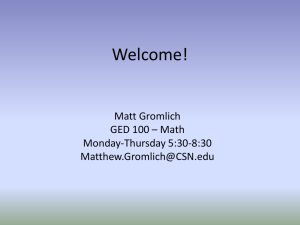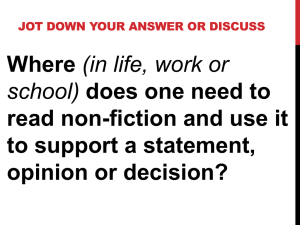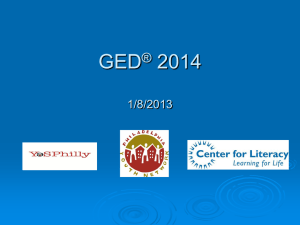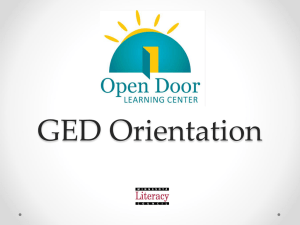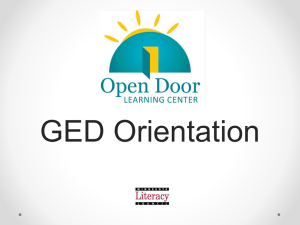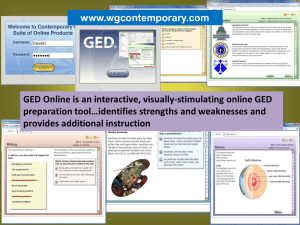Reasoning Through Language Arts
advertisement
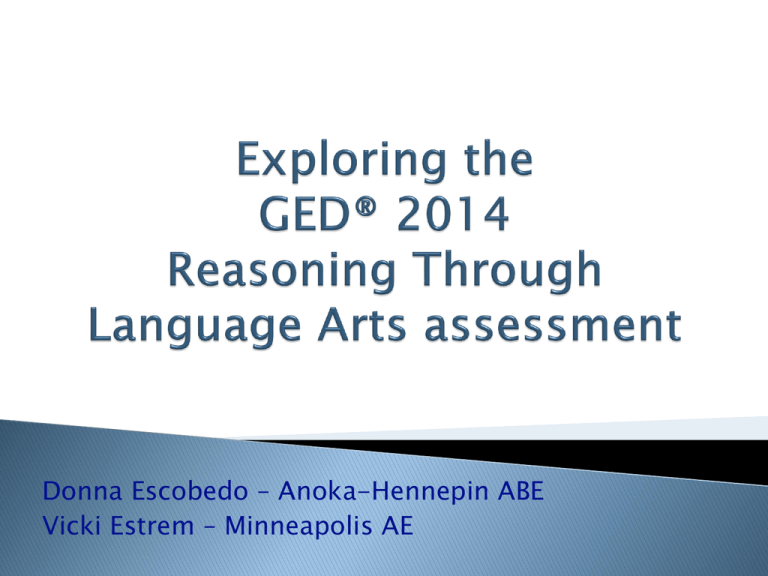
Donna Escobedo – Anoka-Hennepin ABE Vicki Estrem – Minneapolis AE Compare and contrast 2002 and 2014 GED tests Explore and “unpack” RLA assessment targets Review sample test items and digital literacy related to this module Discuss strategies to integrate with current instruction practices Q&A Complete personal PD plan GED 2014 GED 2002 Paper Based Bloom’s Taxonomy/Depth of Knowledge Computer Based Skills: Mouse Skills Basic Keyboarding Tools imbedded in testing software Webb’s Depth of Knowledge Level 1: Recall Level 2: Skills and Concepts Level 3: Strategic Thinking Level 4: Extended Thinking (not assessed) 2 separate tests (Reading & Writing) 1 Integrated Reading/Writing Test GED 2002 Question types: Multiple choice/5 Paragraph Essay Types of reading: 25% nonfiction/75% fiction Passage Lengths 200-400 words GED 2014 Multiple choice, fill-in the blanks, Drag & Drop, Drop down selection, Extended response 75% non-fiction/25% fiction Readings from “Great American Conversation” Passage Lengths 400-900 words New writing skills include responding to informational text and developing an argument that is supported with text based evidence. GED 2002 Holistic scoring with one rubric Response to the prompt Organization Development and details Conventions of Edited American English Word Choice GED 2014 Extended Response: Three Rubrics that evaluates 3 traits from common core standards. Each trait will be scored on a 0-4 scale with a possibility of 12pts total. • • • For more details about the scoring of the RLA extended response: Trait 1; Analysis of Arguments and use of evidence Trait 2: Development of ideas and structure Trait 3: Clarity and command of standard English conventions Refer to Chapter 3 – Assessment Guide for Educators at www.gedtestestingservice.com “Points that test-takers earn in each category will contribute to subscores from each content area. The primary purpose of these subscores will be to give guidance to both test-takers and instructors so that each test-taker can successfully achieve his or her GED test credential.” – chapt. 3 Assessment Guide for Educators RLA Reporting Category Descriptions: 1. Analyzing and creating text features and technique (35%) 2. Using evidence to understand, analyze, and create arguments (45 %) 3. Applying knowledge of English language conventions and usage (20 %) READING ANCHOR STANDARDS “ The reading comprehension component of the GED® RLA Test is intended to measure two overarching reading standards that appear in the Common Core State Standards as Anchor Reading Standards 1 and 10 respectively: Determine the details of what is explicitly stated and make logical inferences or valid claims that square with textual evidence. Read and respond to questions from a range of texts that are from the upper levels of complexity, including texts at the career-and college-ready level of text complexity.” Source: GED Testing Service Assessment Guide for Educators – Chapter 2, p. 2.13 1. 2. 3. 4. 5. 6. Determine central ideas or themes of texts and analyze their development; summarize key supporting details and ideas. Analyze how individuals, events, and ideas develop and interact over the course of a text. Interpret words and phrases that appear frequently in texts from a wide variety of disciplines to include connotative and figurative meaning as well as analyze how word choice shape meaning and tone. Analyze text structure including how specific sentences or paragraphs relate to each other and the whole. Determine author’s point of view, explain how it is conveyed and shapes content and style of text. Explain and evaluate argument and specific claims in text, including validity of reasoning, relevance and sufficiency of evidence. 7. Analyze two or more texts for similar themes/topic. DOK 1 – Recall & Reproduction • Recall, recognize, or locate basic facts, details or ideas explicit in texts • Define terms – use “obvious” context clues • Identify or describe literary elements • Identify specific information contained in graphic representations DOK 2 - Basic Application of Skills/Concepts • Specify, explain, show relationships, explain why, cause-effect • Summarize results, concepts, ideas • Make basic inferences or logical predictions from data or texts • Locate information to support explicit-implicit central ideas • Compare literary elements • Use multiple context clues to identify word/phrase meaning • Distinguish; relevant-irrelevant information; fact/opinion DOK 3 - Strategic Thinking /Reasoning • Apply a concept in a new context • Explain, generalize, or connect ideas using evidence from text • Make more complex inferences supported by reasoning and evidence • Analyze author’s point of view, bias, and literary devices • Critique conclusions drawn and develop alternative solution - from Karin K. Hess: Hess' Cognitive Rigor Matrix www.nciea.org Let’s take a closer look at the reading assessment targets! Using the worksheet at your table, work together to: 1. Rephrase target in “user friendly” language (if needed) 2. Identify activities learner can experience to demonstrate target proficiency. 3. Identify what are you doing NOW in your classroom that addresses these targets Report to large group Dr. Martin Luther King – “Letter from Birmingham Jail” Henry David Thoreau – “On the Duty of Civil Disobedience” WRITING ANCHOR STANDARDS “The writing component integrates reading and writing into meaningful tasks that require the candidate to support their written analysis with evidence drawn from a given source text(s) of appropriate complexity provided in the test.” Common Core Anchor Standards: Draw relevant and sufficient evidence from a literary or information text to support analysis and reflection. Use technology to produce writing, demonstrating sufficient command of keyboarding skills. GED Testing Service Assessment Guide for Educators – Chapter 2, p. 2.17 1. 2. 3. 4. Determine details of what is explicitly stated and make logical inferences or valid claim that is supported with evidence from text. Produce extended analytical response in which writer clearly introduces ideas, writes in logical sequence, develops ideas using evidence from text and maintains coherent focus. Demonstrate command of the conventions of standard English grammar and usage when writing. Demonstrate command of the conventions of standard English capitalization and punctuation when writing. DOK 1 – Recall & Reproduction • Describe /define facts, details, and terms • Select appropriate words when intended meaning /definition is stated • Write simple sentences • Apply rules of basic spelling, grammar, punctuation, conventions, word use • Demonstrate use of basic spelling, grammar, punctuation, conventions, and word use • Decide appropriate text structure according to audience and purpose DOK 2 - Basic Application of Skills/Concepts • Explain, show relationships, explain why, cause-effect • Summarize concepts and ideas • Identify main idea and generalizations of text • Use context to identify meaning of words/phrases • Develop one paragraph text • Distinguish relevant-irrelevant information; fact/opinion • Generate hypotheses based on observations, prior knowledge, and experience. DOK 3 - Strategic Thinking /Reasoning • Explain using supporting evidence • Write multi-paragraph composition for specific purpose • Demonstrate consistent text organization and structure • Analyze interrelationships among concepts, issues, problems • Cite evidence; describe, compare, and contrast solution methods • Justify or critique conclusions - from Karin K. Hess: Hess' Cognitive Rigor Matrix www.nciea.org 1. 2. Issue: Should chocolate milk be allowed in school cafeterias? Read/scan articles Brainstorm Ways to help learners “mine” the texts Pre-writing strategies Use of graphic organizers Mouse Skills: click, scroll, drag and drop, toggle between pages Word Processing Skills: basic keyboarding, cut, copy, paste, undo/redo, insert, enter & hard return, spacing, backspace, highlight Online Tools that will be available to test takers: directional tools, flagging for further review, item review screen Navigation Skills for the CBT : Previous, next, close, and page tabs “These tools have been designed with adult educators in mind, to provide examples of the types of test questions that will be incorporated into the new test, and to help you better understand the knowledge and skills that will be measured on the test. Using these resources should help you to prepare adults to take and succeed on the 2014 GED® test.” – GED Testing Service Item Sampler Download Even though there are big changes ahead, many of these skills are already being taught! 1. 2. 3. Integrate reading and writing which is closer to the way learners will use these skills on the job or in academics. Build critical thinking skills by practicing the reading and writing connection. Many of the current materials can used, but it will take some additional activities that focus on integrating the two areas. Design questions that allow opportunities for learners to analyze and evaluate a reading and then develop an argument supported by texts. Since it is a computer based test, learners must be comfortable working on a computer. Provide opportunities for keyboard and Microsoft Word practice. Practice basic computer skills and encourage learners to work on an additional distance learning program to increase computer skills and comfort. RESOURCES Minneapolis Adult Education 2014 GED test statewide professional development planning http://abe.mpls.k12.mn.us/ged_2014_2 GED Testing Service www.gedtestingservice.com GED Testing Service Assessment Guide for Educators: http://www.gedtestingservice.com/educators/assessment--‐guide--‐for-‐educators GED Testing Service Item Sampler http://www.gedtestingservice.com/educators/itemsampler Common Core State Standards http://www.corestandards.org Texas College and Career Readiness Standards http://www.thecb.state.tx.us/collegereadiness/crs.pdf Virginia Standards of Learning http://www.doe.virginia.gov/testing/sol/standards_docs/index.shtml Project Gutenberg (Public Domain) http://www.gutenberg.org/ Donna Escobedo Anoka-Hennepin Adult Basic Education Donna.Escobedo@anoka.k12.mn.us Vicki Estrem Minneapolis Adult Education victoria.estrem@mpls.k12.mn.us Thank you for attending this overview of the GED® 2014 Reasoning Through Language Arts. Feel free to contact us with questions.
